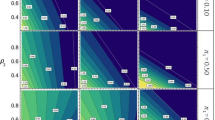Summary
The correlated responses in male and female sterility to 50 generations of individual selection for pupa weight in Tribolium were analyzed. Two replicate lines (S-lines) were selected for heavier pupa weight and stabilizing selection for pupa weight was practiced in two replicate control lines (C-lines). There was close agreement between replicates in both sets of lines for direct and correlated responses. The rate of inbreeding has been constant for all lines (approximately 0.5% per generation).
Regression of generation means for pupa weight on generation of selection indicated a significant linear regression in the direct response for both lines. The linear increases of 46 and 55 μg. per generation in the S-lines accounted for 98% of the variation among generations and the linear decreases of 5 and 10 μg. per generation in the C-lines accounted for 70–90% of the variation in the generation means.
Maximum likelihood estimators were used to calculate the frequency of male and female sterility for each generation and line. Average sterility in the base population ranged from about 4 to 12% for both sexes. Polynomial regressions of percent sterility on generation of selection showed that quadratic and higher order regressions were occasionally significant but accounted for a relatively small fraction of the total variation. In the two S-line replicates, linear regression coefficients of percent sterility on generation number were 0.16±.09 and 0.20±.07 for males and 0.72±.08 and 0.54±.08 for females, suggesting a larger correlated response in female than in male sterility. In the C-lines, linear regression coefficients were 0.02±.08 and −.12±.05 for males in the two replicates and −.05±.05 and −.05±.05 for females. Estimates of realized genetic correlations between pupa weight and sterility in the S-lines ranged from 0.04 to 0.14 for males and from 0.14 to 0.37 for females when the heritability of sterility was allowed to take on values from 0.05 to 0.25.
Similar content being viewed by others
Literature Cited
Abplanalp, H.: Modification of selection limits for egg number. Genet. Res. 3, 210–225 (1962).
Bohren, B. B., Hill, W. G., Robertson, A.: Some observations on asymmetrical correlated response to selection. Genet. Res. 7, 44–57 (1966).
Bray, D. F., Bell, A. E., King, S. C.: The importance of genotype by environment interaction with reference to control populations. Genet. Res. 3, 282–302 (1962).
Brown, W. P., Bell, A. E.: Genetic analysis of a “plateaued” population of Drosophila melanogaster. Genetics 46, 407–425 (1961).
Clayton, G. A., Knight, G. R., Morris, J. A., Robertson, A.: An experimental check on quantitative genetical theory. III. Correlated responses. J. Genet. 55, 171–180 (1957).
Clayton, G. A., Robertson, A.: An experimental check on quantitative genetical theory. II. The longterm effects of selection. J. Genet. 55, 152–170 (1957).
Dawson, P. S.: Genetic homeostasis and developmental rate in Tribolium. Genetics 51, 873–885 (1965).
Dawson, P. S.: Correlated responses to selection for developmental rate in Tribolium. Genetica 37, 63–77 (1966).
Dempster, E. R., Lerner, I. M., Lowry, D. C.: Continuous selection for egg production in poultry. Genetics 37, 693–708 (1952).
Enfield, F. D.: Selection in Tribolium: Correlated response in reproductive traits. J. Animal Sci. 29, 106–107 (1969).
Enfield, F. D., Comstock, R. E., Braskerud, O.: Selection for pupa weight in Tribolium castaneum. I. Parameters in base populations. Genetics 54, 523–533 (1966).
Falconer, D. S.: Selection for large and small size in mice. J. Genet. 51, 470–501 (1953).
Falconer, D. S.: Validity of the theory of genetic correlation. An experimental test with mice. J. Heredity 45, 42–44 (1954).
Falconer, D. S.: Introduction to Quantitative Genetics. New York: Ronald Press Co. 1960a.
Falconer, D. S.: Selection of mice for growth, on high and low planes of nutrition. Genet. Res. 1, 91–113 (1960b).
Falconer, D. S., King, J. W. B.: A study of selection limits in the mouse. J. Genet. 51, 561–581 (1953).
Fowler, R. E., Edwards, R. G.: The fertility of mice selected for large or small body size. Genet. Res. 1, 393–407 (1960).
Hiraizumi, Y.: Negative correlation between rate of development and female fertility in Drosophila melanogaster. Genetics 46, 615–624 (1961).
Hollingsworth, M. J., Smith, J. M.: The effects of inbreeding on rate of development and on fertility in Drosophila subobscura. J. Genet. 53, 295–314 (1955).
Latter, B. D. H.: Selection for a threshold character in Drosophila. II. Homeostatic behaviour on relaxation of selection. Genet. Res. 8, 205–218 (1966).
Latter, B. D. H., Robertson, A.: The effects of inbreeding and artificial selection on reproductive fitness. Genet. Res. 3, 110–138 (1962).
Lerner, I. M.: The effect of selection for shank length on sexual maturity and early egg weight in Single Comb White Leghorn pullets. Poultry Sci. 25, 204–209 (1946).
Lerner, I. M.: Genetic Homeostasis. Edinburgh: Oliver and Boyd 1954.
Lerner, I. M., Dempster, E. R.: Attenuation of genetic progress under continued selection in poultry. Heredity 5, 75–94 (1951).
Roberts, R. C.: The limits to artificial selection for body weight in the mouse. III. Selection from crosses between previously selected lines. Genet. Res. 9, 73–85 (1967a).
Roberts, R. C.: The limits to artificial selection for body weight in the mouse. IV. Sources of new genetic variance-irradiation and outcrossing. Genet. Res. 9, 87–98 (1967b).
Verghese, M. W., Nordskog, A. W.: Correlated responses in reproductive fitness to selection in chickens. Genet. Res. 11, 221–238 (1968).
Yamada, Y., Bohren, B. B., Crittenden, L. B.: Genetic analysis of a White Leghorn closed flock apparently plateaued for egg production. Poultry Sci. 37, 565–580 (1958).
Author information
Authors and Affiliations
Additional information
Communicated by H. Abplanalp
Supported by NSF Grants G-1238 and GB-5987, NIH Grant GM-16074 and NIH Fellowship 1 FO2 GM4 5130-01.
Rights and permissions
About this article
Cite this article
Kress, D.D., Enfield, F.D. & Braskerud, O. Correlated response in male and female sterility to selection for pupa weight in Tribolium castaneum . Theoret. Appl. Genetics 41, 197–202 (1971). https://doi.org/10.1007/BF00279769
Received:
Issue Date:
DOI: https://doi.org/10.1007/BF00279769




